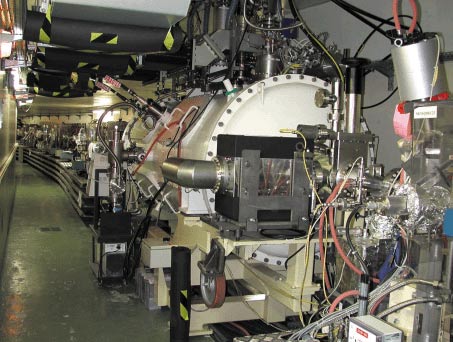- Home
- Users & Science
- Scientific Documentation
- ESRF Highlights
- ESRF Highlights 2002
- The X-ray Source
- Test of the SOLEIL Superconducting Cavity
Test of the SOLEIL Superconducting Cavity
A cryo-module housing two superconducting 352 MHz strongly HOM-damped cavities has been developed within the framework of the SOLEIL project design study phase, in a collaboration between CEA, CERN, ESRF and SOLEIL. In 2002 the prototype was installed in the ESRF storage ring (Figure 136) and tested with beam in the accelerating regime at 4.5 K with the cavities cooled by liquid helium poured from Dewars. Four such tests were carried out at the end of scheduled shutdowns at the ESRF. In order to avoid disturbing the ESRF machine performance during user mode operation, the cavities were maintained detuned at room temperature in a passive regime. The heat generated by the beam was then evacuated by means of a helium gas flow, cooled by a heat exchanger.
 |
|
Fig. 136: Superconducting HOM-free SOLEIL cavity in cell 23 of the ESRF storage ring. |
In passive operation at 300 K or 4 K, no instability was detected up to the maximum ESRF intensity of 200 mA: this demonstrated the validity of the concept of an effective damping of the Higher Order Modes (HOM). With the cavity at room temperature, the test arrangement provoked only three beam trips over one year and was therefore almost transparent to the normal ESRF operation.
The superconducting module was also tested successfully in the accelerating regime with 3 MV of accelerating voltage. A maximum power of 360 kW could then be transferred to 170 mA of beam. This power was limited by minor problems of spurious coupling of the dipolar HOM couplers to the fundamental accelerating mode. Corresponding modifications are therefore planned prior to the installation on the SOLEIL storage ring. The tests also showed that a cold shield could help to reduce the static cryogenic losses, thereby limiting the liquid helium consumption, which is presently above specifications. Nevertheless, the achieved performances of the prototype module are already sufficient for the first operation phase of SOLEIL. For long-term operation the production of a second improved module will be launched in parallel.
Due to the successful prototype test, the concept of this almost HOM-free superconducting cavity has been validated. Full evaluation of the beam tests at the ESRF will contribute to finalise the design. The tests have also shown that this cavity constitutes a valuable option for a possible future intensity upgrade at the ESRF.



